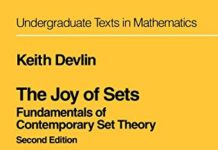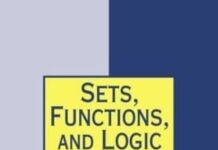
Ebook Info
- Published: 2015
- Number of pages: 104 pages
- Format: PDF
- File Size: 1.23 MB
- Authors: Keith Devlin
Description
In the twenty-first century, everyone can benefit from being able to think mathematically. This is not the same as “doing math.” The latter usually involves the application of formulas, procedures, and symbolic manipulations; mathematical thinking is a powerful way of thinking about things in the world — logically, analytically, quantitatively, and with precision. It is not a natural way of thinking, but it can be learned. Mathematicians, scientists, and engineers need to “do math,” and it takes many years of college-level education to learn all that is required. Mathematical thinking is valuable to everyone, and can be mastered in about six weeks by anyone who has completed high school mathematics. Mathematical thinking does not have to be about mathematics at all, but parts of mathematics provide the ideal target domain to learn how to think that way, and that is the approach taken by this short but valuable book. The book is written primarily for first and second year students of science, technology, engineering, and mathematics (STEM) at colleges and universities, and for high school students intending to study a STEM subject at university. Many students encounter difficulty going from high school math to college-level mathematics. Even if they did well at math in school, most are knocked off course for a while by the shift in emphasis, from the K-12 focus on mastering procedures to the “mathematical thinking” characteristic of much university mathematics. Though the majority survive the transition, many do not. To help them make the shift, colleges and universities often have a “transition course.” This book could serve as a textbook or a supplementary source for such a course. Because of the widespread applicability of mathematical thinking, however, the book has been kept short and written in an engaging style, to make it accessible to anyone who seeks to extend and improve their analytic thinking skills. Going beyond a basic grasp of analytic thinking that everyone can benefit from, the STEM student who truly masters mathematical thinking will find that college-level mathematics goes from being confusing, frustrating, and at times seemingly impossible, to making sense and being hard but doable. Dr. Keith Devlin is a professional mathematician at Stanford University and the author of 31 previous books and over 80 research papers. His books have earned him many awards, including the Pythagoras Prize, the Carl Sagan Award, and the Joint Policy Board for Mathematics Communications Award. He is known to millions of NPR listeners as “the Math Guy” on Weekend Edition with Scott Simon. He writes a popular monthly blog “Devlin’s Angle” for the Mathematical Association of America, another blog under the name “profkeithdevlin”, and also blogs on various topics for the Huffington Post.
User’s Reviews
Reviews from Amazon users which were colected at the time this book was published on the website:
⭐This is a great book for filling the gap that we face in making a transition from grade school to more advanced, college-level math. It is very short, and so can be read and studied as a supplement for other math-related studies. It is basically about the important shift in perspective from using math as a calculational tool to understanding and communicating math to others. This transition mainly requires some knowledge and skill at proofs, and a basic appreciation of why this “grammar” (which is not an area that normally impedes us much in understanding or communicating in a spoken language like English) becomes so important in math. Professor Devlin addresses this ably, and evinces in this short book, his immense insight into teaching math. He accomplishes a lot in this short book, and I think it is extremely important to learn the types of basic concepts and methods he discusses at the earliest possible age at which a student can appreciate this. Although a short work, his book contains numerous exercises, and it would be wise for the beginning student to at least attempt many. Proofs, and an appreciation of the value and significance of “pure” mathematics are extremely important in progress in many fields of science, math and engineering. Because he is very precisely addressing one of the most serious problems in making a transition to advanced math, and in a very lucid, intelligent way, I can strongly recommend this book. Many people want to use math only intuitively and/or as a tool, but to progress in math, we must absolutely confront the extreme importance of rigorous mathematics, and understanding math adequately. Of course, there is a vast difference between the basic skills, of, for example, proving relatively simple theorems, and coming up with proofs, which amounts to a skill that is not uncommonly associated with the highest levels of art, ingenuity, insight, and, not infrequently, genius. But, climbing that hill is one far beyond the scope of what Prof. Devlin is trying to communicate in his book. While a really great book, it is probably best to accompany studying it with some assistance from a tutor or a teacher.Here is a bit of perspective on exploration and adventure in math, and the world Professor Devlin is trying to help us, as far as opening our minds: As a teacher, I have been working at my own study in math. I finally got a hand calculation I was working on for what I am studying with Lagrangians (with respect to calculus of variations and the theory of PDEs) to work out. I have to say that there are the moments of fun, when one does something really nice or gets to use some really nice software (like the stuff that the number theory enthusiasts use to detect Mersenne primes for calibrating supercomputers and for cryptography), but hand calculations are not always so much fun. Furthermore, in order to learn physics and math, and have an understanding of what the abstractions mean, you have to make some contact with calculations, with experiments, and do some hard work. It’s not just a matter of reading about cool theory. We all like the adventure and the great exploration that math and physics and engineering represent (and really, that is at the heart of what our species is about and what makes us humans a little different from other organisms), but there is always the price of hard work that has to be paid. We can’t always let others pay that price, or expect AI or computers to make it easy, if we want to understand and progress. You can spare yourself a lot of time and effort if you are extremely clever, or a genius like Feynman or Villani, that’s for sure. But I think the adventure of physics and math is for all of us, not just the extremely clever or the geniuses.
⭐For the size of this small book Mr. Devlin is a HIT! It is filled with information and ideas that connect math to actually thinking about it and not just memorizing Algorithms but truly thinking about why! This book is part of the best reading of this year. It is well suited to high school and early college years. I am a teacher and this book has added to my thinking tool chest.
⭐Very interesting reading, made me realize the similarity between writing with intelligent grammar and analytic thinking.
⭐This is a polished presentation of mathematics used in a Coursera onling Class, the purpose is for high school students to transistion into College. Presents a rigious way of thinking and some noncomputational math not usually part of high school. Highly recommend taking the class. Not necessary to have the book, but it helpful to have your own copy. I hope Dr. Devlin makes a little money for his efforts. I am working on a letter to Tom Luna, superintendent of Schools in Idaho. I think his idea of online classes is right, but his implementation needs to be more thoughtful with mentor. This class is the future of learning.
⭐I learned about this book while taking the class of the same subject by the same author. I ordered the book to refresh and restudy the subject matter i.e how to think about math. I have taken several logic courses. But the subject matter of this book is an introduction to the root of all logical thinking. The subject matters was an enlightening and clarifying experience. Professor Devlin has a lot of experience in teaching this subject and he has broken down the concepts into the bare essentials. I really believe that the author is on a sincere mission to teach mathematical thinking and reasoning in general. I am reading the book and the concepts again and it is clearer to me the second time around. I have also take several math and statistics courses and I wish I had a base in Mathematical Thinking before I studied these subjects – this would have saved a lot angst over the abstract nature of learning mathematical procedures. I learned and forgot lot of these procedures but I know understand the reasoning for these procedures and see them in a different perspective – thanks Prof. Devlin.
⭐Devlin teaches a most unique and innovative way of mathematical thinking. I used this book in connection with a course Devlin gives on coursera.org. While the approach focuses on thinking about things in the world, it includes logical and analytic thinking as well as quantitative reasoning. Highly recommended, especially for high school students transitioning to college math.
⭐This is an excellent book if you want to make the transition from high-school style mathematical thinking to the type of thinking required for university level maths. It has a lot of good stuff on proofs, induction, conditionals, some basic number theory and real analysis.I took the Coursera course that Keith Devlin is the instructor for as well, it basically covers the same ground as this book, and is also highly recommended. A word of warning: this book (and the Coursera course) is for those who are willing to work at changing their thinking, and it does contain some concepts and maths that some would consider a bit more than elementary. But if you are willing to work at it (like I did), the rewards will pay off greatly. Highly recommended book!
⭐I used it as an introduction to proof for my kids who are starting in advanced university math
⭐This is an excellent and inexpensive companion to Prof. Keith Devlin’s Coursera course.Here, “mathematical thinking” refers to the kind of formal logic that one might find early-on in an undergraduate mathematics course, but don’t be put-off by that as it doesn’t mean you need much of a background in high school mathematics; it’s basic, logical, deductive reasoning expressed formally in mathematical shorthand. It’s a valuable practical tool for everyday thinking and this ought to be taught in our primary schools as a foundation for many other things – and not just maths and sciences.In this respect, Devlin’s book is a concise and inexpensive alternative to Burger & Starbird’s “The Heart of Mathematics: An Invitation to Effective Thinking” (another book associated with an excellent on-line course). While Burger & Starbird is lavish, it’s also very expensive.While it seems that school mathematics is increasingly about learning how to “turn a handle” to do things in a hurry and without much real insight, Devlin places particular emphasis on taking things slowly in order to think about and understand the concepts. The exercises are an essential part of the book and although there are no solutions, you’ll mostly know when you have the right answer if you’ve understood what’s going on – and if you don’t, then go back and think about it; as Devlin says repeatedly: don’t rush!. In addition, Devlin’s Coursera on-line course is very well worthwhile (and free) and discusses many of the problems.
⭐I have the print copy but decided to get the EBook for my Kindle Fire. Firstly this is an excellent introduction to logic and mathematical proof. However, being a ‘mathematical’ text there are a lot of Greek characters – some of which do not reproduce on the Kindle Fire – leaving a series of empty squares. Strangely enough this is not reproduced on my Kindle for Ipad app. Other than that flaw it woukld get 5 stars.
⭐Excellent alongside Coursera on-line course by Keith Devlin himself.
⭐A good and accessible introduction to mathematical reasoning, with exercises to test your comprehension. It covers logic and mathematical proof, and does not require much previous mathematical knowledge, so it is accessible to lay readers as well as people studying maths at school or university.
⭐Keith Devlin makes mathematics interesting. This is something none of my maths teachers achieved when I was at school. If you think you are not very good a maths don’t worry this book will awake a hidden interest in the subject. I read it because I took the Coursera course on the Introduction to Mathematical Thinking. So if you would like to think like a mathematician or, as in my case aspire to, then this book is essential reading.
Keywords
Free Download Introduction to Mathematical Thinking in PDF format
Introduction to Mathematical Thinking PDF Free Download
Download Introduction to Mathematical Thinking 2015 PDF Free
Introduction to Mathematical Thinking 2015 PDF Free Download
Download Introduction to Mathematical Thinking PDF
Free Download Ebook Introduction to Mathematical Thinking



